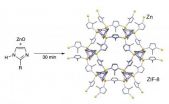(Press-News.org) Using powerful gene-analysis tools, researchers have discovered mutations in two related genes, ARID1A and ARID1B, that are involved in the most aggressive form of the childhood cancer neuroblastoma. While these findings do not immediately improve clinical treatments, they identify a novel pathway that is defective in these cancers, a pathway that scientists can now study to develop potential new therapies.
"These gene alterations were not previously known to be mutated in neuroblastoma, and they may significantly advance our knowledge of the underlying biological pathways that drive this disease," said study leader Michael D. Hogarty, M.D., a pediatric oncologist at The Children's Hospital of Philadelphia. "These two genes function in a group of genes that seems to play an important role in neural cell behavior, and we will now work to discover if this insight may open up new treatments for children with tumors having these mutations."
Hogarty, along with Victor Velculescu, M.D., Ph.D., of the Johns Hopkins Kimmel Cancer Center, co-led the study that appeared today in Nature Genetics.
The scientists received over $1 million in funding from the St. Baldrick's Foundation, a volunteer-driven and donor-centered charity dedicated to raising money for childhood cancer research.
The current study employed sophisticated next-generation sequencing technology that identified the entire DNA sequence for a set of neuroblastoma tumors. "When this project started, it was the first of its kind to focus on a childhood tumor," said Hogarty. "This is important, because cataloguing all the DNA mutations in neuroblastoma, or any tumor, will allow us to better understand the enemy, and ultimately to make better treatment decisions."
Striking the peripheral nervous system, neuroblastoma usually appears as a solid tumor in the chest or abdomen of young children. It accounts for 7 percent of all childhood cancers, but 10 to 15 percent of all childhood cancer-related deaths.
In the current study, Hogarty and colleagues identified alterations in two genes, ARID1A and ARID1B, neither of which had previously been reported to be involved in neuroblastoma. Both genes are thought to affect chromatin, a combination of DNA and protein that regulates the activities of genes and ultimately controls the behavior of a cell. During normal development, neural cells switch from a primitive, rapidly dividing state (neuroblasts) into a more differentiated, or mature state (neurons).
However, said Hogarty, mutations in ARID1A and ARID1B may prevent this orderly transition, keeping the neural cells in the uncontrolled stage of growth that becomes a cancerous tumor. "Unfortunately, children with these mutations have a particularly aggressive, treatment-resistant form of neuroblastoma," he added. The current study found that ARID1A and ARID1B mutations occur in 5 to 15 percent of high-risk neuroblastomas, but the pathway these genes affect may have a broader role in the disease—a possibility that Hogarty and colleagues plan to investigate further. It is possible that children having tumors with these mutations will receive more aggressive or more experimental treatments in the future.
Ultimately, said Hogarty, studies of the pathway affected by these genes may lay the foundation for future targeted therapies aimed at this pathway.
In the current study, the scientists also developed an approach that detects the tumor DNA abnormalities in the blood. "All tumors harbor genetic mistakes that leave a fingerprint in the DNA, and tumor DNA is often detected in the blood as well," he explained. "We may be able to develop a blood test, personalized to each cancer patient, to detect their tumor fingerprint in circulating blood DNA. This would permit oncologists to more accurately monitor patients for treatment response and recurrence, and offer a tool to help guide treatment decisions."
###
In addition to funding from St. Baldrick's, this study also received support from the National Institutes of Health (grant CA121113), the Children's Oncology Group, the Virginia and D.K. Ludwig Fund for Cancer Research, Swim Across America, and the AACR Stand Up to Cancer-Dream Team Translational Cancer Research Grant.
"Integrated genomic analyses identify ARID1A and ARID1B alterations in the childhood cancer neuroblastoma," Nature Genetics, advance online publication, Dec. 2, 2012. doi: 10.1038/ng.2493
About The Children's Hospital of Philadelphia: The Children's Hospital of Philadelphia was founded in 1855 as the nation's first pediatric hospital. Through its long-standing commitment to providing exceptional patient care, training new generations of pediatric healthcare professionals and pioneering major research initiatives, Children's Hospital has fostered many discoveries that have benefited children worldwide. Its pediatric research program is among the largest in the country, ranking third in National Institutes of Health funding. In addition, its unique family-centered care and public service programs have brought the 516-bed hospital recognition as a leading advocate for children and adolescents. For more information, visit http://www.chop.edu.
New gene-sequencing tools offer clues to highest-risk form of a childhood cancer
2 gene mutations I.D.'d in neuroblastoma, says researcher from the Children's Hospital of Philadelphia
2012-12-03
ELSE PRESS RELEASES FROM THIS DATE:
Genes linked to low birth weight, adult shortness and later diabetes risk
2012-12-03
An international team of genetics researchers has discovered four new gene regions that contribute to low birth weight. Three of those regions influence adult metabolism, and appear to affect longer-term outcomes such as adult height, risk of type 2 diabetes and adult blood pressure.
"This large study adds to the evidence that genes have a strong influence on fetal growth," said one of the co-authors, Struan F.A. Grant, Ph.D., associate director of the Center for Applied Genomics at The Children's Hospital of Philadelphia. "The cumulative effect of the genes is surprisingly ...
Scientists at Scripps Research Institute discover how 2 proteins help keep cells healthy
2012-12-03
LA JOLLA, CA – December 2, 2012 – Scientists at The Scripps Research Institute (TSRI) have determined how two proteins help create organelles, or specialized subunits within a cell, that play a vital role in maintaining cell health. This discovery opens the door for research on substances that could interfere with the formation of these organelles and lead to new therapies for cancer.
The study, published online ahead of print on December 2, 2012, by the journal Nature Structural & Molecular Biology, focuses on the structure and function of the two proteins, ATG12 and ...
Scientists find 'bully' genes in common childhood tumor
2012-12-03
In a genome sequencing study of 74 neuroblastoma tumors in children, scientists at the Johns Hopkins Kimmel Cancer Center and the Children's Hospital of Philadelphia (CHOP) found that patients with changes in two genes, ARID1A and ARID1B, survive only a quarter as long as patients without the changes. The discovery could eventually lead to early identification of patients with aggressive neuroblastomas who may need additional treatments.
Neuroblastomas affect nerve tissue throughout the body and are the most common, non-blood cancer in children. "These cancers have a ...
Origin of intelligence and mental illness linked to ancient genetic accident
2012-12-03
Scientists have discovered for the first time how humans – and other mammals – have evolved to have intelligence.
Researchers have identified the moment in history when the genes that enabled us to think and reason evolved.
This point 500 million years ago provided our ability to learn complex skills, analyse situations and have flexibility in the way in which we think.
Professor Seth Grant, of the University of Edinburgh, who led the research, said: "One of the greatest scientific problems is to explain how intelligence and complex behaviours arose during evolution." ...
Childhood trauma leaves mark on DNA of some victims
2012-12-03
This press release is available in German.
Abused children are at high risk of anxiety and mood disorders, as traumatic experience induces lasting changes to their gene regulation. Scientists from the Max Planck Institute of Psychiatry in Munich have now documented for the first time that genetic variants of the FKBP5 gene can influence epigenetic alterations in this gene induced by early trauma. In individuals with a genetic predisposition, trauma causes long-term changes in DNA methylation leading to a lasting dysregulation of the stress hormone system. As a result, ...
A shock to pollution in chemistry
2012-12-03
Solvents are omnipresent in the chemical industry, and are a major environmental and safety concern. Therefore the large interest in mechanochemistry: an energy-efficient alternative that avoids using bulk solvents and uses high-frequency milling to drive reactions. Milling is achieved by the intense impact of steel balls in a rapidly moving jar, which hinders the direct observation of underlying chemistry. Scientists have now for the first time studied a milling reaction in real time, using highly penetrating X-rays to observe the surprisingly rapid transformations as ...
Cell surface transporters exploited for cancer drug delivery
2012-12-03
CAMBRIDGE, Mass. (December 2, 2012) –Whitehead Institute scientists report that certain molecules present in high concentrations on the surfaces of many cancer cells could be exploited to funnel lethal toxic molecules into the malignant cells. In such an approach, the overexpression of specific transporters could be exploited to deliver toxic substances into cancer cells.
Although this finding emerges from the study of a single toxic molecule and the protein that it transports, Whitehead Member David Sabatini says this phenomenon could be leveraged more broadly.
"Our ...
Surprising results from study of non-epileptic seizures
2012-12-03
MAYWOOD, Il. - A Loyola University Medical Center neurologist is reporting surprising results of a study of patients who experience both epileptic and non-epileptic seizures.
Non-epileptic seizures resemble epileptic seizures, but are not accompanied by abnormal electrical discharges. Rather, these seizures are believed to be brought on by psychological stresses.
Dr. Diane Thomas reported that 15.7 percent of hospital patients who experienced non-epileptic seizures also had epileptic seizures during the same hospital stay. Previous studies found the percentage of such ...
A better way to make chemicals?
2012-12-03
Bulk solvents, widely used in the chemical industry, pose a serious threat to human health and the environment. As a result, there is growing interest in avoiding their use by relying on "mechanochemistry" – an energy-efficient alternative that uses high-frequency milling to drive reactions. Because milling involves the intense impact of steel balls in rapidly moving jars, however, the underlying chemistry is difficult to observe.
Now, for the first time, scientists have studied a milling reaction in real time, using highly penetrating X-rays to observe the surprisingly ...
Glowing fish shed light on metabolism
2012-12-03
A tiny, translucent zebrafish that glows green when its liver makes glucose has helped an international team of researchers identify a compound that regulates whole-body metabolism and appears to protect obese mice from signs of metabolic disorders.
Led by scientists at the University of California, San Francisco (UCSF), the work demonstrates how a fish smaller than a grain of rice can help screen for drugs to help control obesity, type 2 diabetes and other metabolic disorders, which affect a rising 34 percent of American adults and are major risk factors for cardiovascular ...
LAST 30 PRESS RELEASES:
New Zealand researchers identify brain link to high blood pressure
New research confirms people with ME/CFS have a consistent faulty cellular structure
Hidden cancer risk behind fatty liver disease targets
Born in brightness, leading to darkness
Boron-containing Z-type and bilayer benzoxene
Hong Kong researchers break the single-field barrier with dual-field assisted diamond cutting
Work hard, play hard?
Wood becomes smart glass: Photo- and electro-chromic membrane switches tint in seconds
The Lancet: COVID-19 vaccine hesitancy decreased over time, though mistrust persists among certain groups, study of over 1 million people in England suggests
Psychosis patients ‘living in metaphor’ -- new study radically shifts ideas about delusions
Clinical trial in Ethiopia targets the trachoma scourge
Open-sourcing the future of food
Changes in genetic structure of yeast lead to disease-causing genomic instabilities
UC San Diego Health Sciences Grant Writing Course helps launch successful research careers
Study: Many head and neck cancer trials end early. Why?
Tufts vice provost for research named Foreign Fellow of Indian National Science Academy
New model improves prediction of prostate cancer death risk
Two wrongs make a right: how two damaging variants can restore health
Overlooked decline in grazing livestock brings risks and opportunities
Using rare sugars to address alcoholism
Research alert: New vulnerability identified in aggressive breast cancer
Ruth Harris honored with SSA Distinguished Service Award
Treasure trove of data on aging publicly accessible
Trees4Adapt project to address risks from climate change and biodiversity loss through tree-based solutions
Nature Communications study from the Lundquist Institute identifies molecular mechanism underlying peripartum cardiomyopathy
Pennington Biomedical’s Dr. Gang Hu appointed to NIH Reproductive, Perinatal and Pediatric Health Review Group
World-first project shows great promise to treat low eye pressure
New technique puts rendered fabric in the best light
Brain cancer digital twin predicts treatment outcomes
Cat disease challenges what scientists thought about coronaviruses
[Press-News.org] New gene-sequencing tools offer clues to highest-risk form of a childhood cancer2 gene mutations I.D.'d in neuroblastoma, says researcher from the Children's Hospital of Philadelphia




